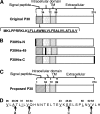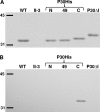Processing is required for a fully functional protein P30 in Mycoplasma pneumoniae gliding and cytadherence
- PMID: 21821772
- PMCID: PMC3187232
- DOI: 10.1128/JB.00104-11
Processing is required for a fully functional protein P30 in Mycoplasma pneumoniae gliding and cytadherence
Abstract
The cell wall-less prokaryote Mycoplasma pneumoniae causes bronchitis and atypical pneumonia in humans. Mycoplasma attachment to the host respiratory epithelium is required for colonization and mediated largely by a differentiated terminal organelle. P30 is an integral membrane protein located at the distal end of the terminal organelle. The P30 null mutant II-3 is unable to attach to host cells and nonmotile and has a branched cellular morphology compared to the wild type, indicating an important role for P30 in M. pneumoniae biology. P30 is predicted to have an N-terminal signal sequence, but the presence of such a motif has not been confirmed experimentally. In the current study we analyzed P30 derivatives having epitope tags engineered at various locations to demonstrate that posttranslational processing occurred in P30. Several potential cleavage sites predicted in silico were examined, and a processing-defective mutant was created to explore P30 maturation further. Our results suggested that signal peptide cleavage occurs between residues 52 and 53 to yield mature P30. The processing-defective mutant exhibited reduced gliding velocity and cytadherence, indicating that processing is required for fully functional maturation of P30. We speculate that P30 processing may trigger a conformational change in the extracellular domain or expose a binding site on the cytoplasmic domain to allow interaction with a binding partner as a part of functional maturation.
Figures







Similar articles
-
Domain analysis of protein P30 in Mycoplasma pneumoniae cytadherence and gliding motility.J Bacteriol. 2011 Apr;193(7):1726-33. doi: 10.1128/JB.01228-10. Epub 2011 Jan 21. J Bacteriol. 2011. PMID: 21257768 Free PMC article.
-
P65 truncation impacts P30 dynamics during Mycoplasma pneumoniae gliding.J Bacteriol. 2012 Jun;194(11):3000-7. doi: 10.1128/JB.00091-12. Epub 2012 Apr 27. J Bacteriol. 2012. PMID: 22544269 Free PMC article.
-
Insights into the function of Mycoplasma pneumoniae protein P30 from orthologous gene replacement.Microbiology (Reading). 2011 Oct;157(Pt 10):2862-2870. doi: 10.1099/mic.0.052464-0. Epub 2011 Jul 21. Microbiology (Reading). 2011. PMID: 21778204 Free PMC article.
-
Mycoplasma pneumoniae cytadherence: unravelling the tie that binds.Mol Microbiol. 1996 Apr;20(2):247-53. doi: 10.1111/j.1365-2958.1996.tb02613.x. Mol Microbiol. 1996. PMID: 8733224 Review.
-
Adhesion proteins of Mycoplasma pneumoniae.Front Biosci. 2007 Jan 1;12:690-9. doi: 10.2741/2093. Front Biosci. 2007. PMID: 17127329 Review.
Cited by
-
Behaviors and Energy Source of Mycoplasma gallisepticum Gliding.J Bacteriol. 2019 Sep 6;201(19):e00397-19. doi: 10.1128/JB.00397-19. Print 2019 Oct 1. J Bacteriol. 2019. PMID: 31308069 Free PMC article.
-
Reviewing advancement in Mycoplasma pneumoniae P30 adhesin protein provides insights for future diagnosis and treatment.Front Microbiol. 2024 Dec 13;15:1515291. doi: 10.3389/fmicb.2024.1515291. eCollection 2024. Front Microbiol. 2024. PMID: 39735188 Free PMC article. Review.
-
Serological diagnosis of Mycoplasma pneumoniae infection by using the mimic epitopes.World J Microbiol Biotechnol. 2018 May 29;34(6):82. doi: 10.1007/s11274-018-2467-y. World J Microbiol Biotechnol. 2018. PMID: 29845357
-
Modulation of P1 and EGF expression by Baicalin.Int J Mol Sci. 2012 Dec 20;14(1):146-57. doi: 10.3390/ijms14010146. Int J Mol Sci. 2012. PMID: 23344025 Free PMC article.
-
Insights into the pathogenesis of Mycoplasma pneumoniae (Review).Mol Med Rep. 2016 Nov;14(5):4030-4036. doi: 10.3892/mmr.2016.5765. Epub 2016 Sep 23. Mol Med Rep. 2016. PMID: 27667580 Free PMC article. Review.
References
-
- Baseman J. B., et al. 1987. Identification of a 32-kilodalton protein of Mycoplasma pneumoniae associated with hemadsorption. Isr. J. Med. Sci. 23:474–479 - PubMed
-
- Biscardi S., et al. 2004. Mycoplasma pneumoniae and asthma in children. Clin. Infect. Dis. 38:1341–1346 - PubMed
-
- Collier A. M., Clyde W. A., Jr., Denny F. W. 1971. Mycoplasma pneumoniae in hamster tracheal organ culture: immunofluorescent and electron microscopic studies. Proc. Soc. Exp. Biol. Med. 136:569–573 - PubMed
Publication types
MeSH terms
Substances
Grants and funding
LinkOut - more resources
Full Text Sources
Other Literature Sources

